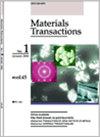Modeling of Yield Surfaces for A5052 Aluminum Alloy Sheets with Different Tempers by Simplified Identification Method and Its Experimental Validation
IF 1.9
4区 材料科学
Q4 MATERIALS SCIENCE, MULTIDISCIPLINARY
引用次数: 0
Abstract
Yield surfaces of A5052 aluminum alloy sheets with different tempers are modeled by the simplified identification method using the circumscribing polygon. In this method, a polygon circumscribing the equal plastic work contour is determined by uniaxial tensile, equal biaxial tensile and plane strain tensile tests. Anisotropic yield surfaces of A5052 aluminum alloy sheet are modeled by Yld2000-2d (Barlat et al., 2003) and Yld2004-18p (Barlat et al., 2005) yield functions. Both yield functions can express the inscribed curves of the polygons. The modeled yield surfaces of A5052-O agree with the stress points of the equal plastic work contours measured by the reliable bi-axial tensile tests. The proposed method to identify the yield function is effective for aluminum sheet metal. On the other hand, the two identified yield functions show different in-plane plastic anisotropy in the tension-compression combined stress state. To examine the suitability of identified models, the experiments and numerical analyses of the deep drawing tests are carried out. Comparing the experimental and analyzed results, the predicted ear height of drawn cup using the Yld2004-18p yield function agree with experimental results qualitatively. But the prediction of the ear using the Yld2000-2d cannot express the tendency of the experimental one.不同回火状态A5052铝合金薄板屈服面简化识别建模及实验验证
采用边界多边形简化识别方法,对不同回火状态下的A5052铝合金薄板屈服曲面进行了建模。在该方法中,通过单轴拉伸、等双轴拉伸和平面应变拉伸试验确定等量塑性工作轮廓的多边形。A5052铝合金薄板的各向异性屈服面采用Yld2000-2d (Barlat et al., 2003)和Yld2004-18p (Barlat et al., 2005)屈服函数建模。两种屈服函数都可以表示多边形的内切曲线。模拟的A5052-O屈服面与可靠的双轴拉伸试验测得的等塑性工作轮廓的应力点一致。本文提出的屈服函数识别方法对铝板的屈服函数识别是有效的。另一方面,两种屈服函数在拉压复合应力状态下表现出不同的面内塑性各向异性。为了验证所识别模型的适用性,进行了深拉深试验的实验和数值分析。将实验结果与分析结果进行比较,利用Yld2004-18p屈服函数预测的拔杯穗高与实验结果定性一致。但是利用Yld2000-2d对耳朵的预测不能表达实验的趋势。
本文章由计算机程序翻译,如有差异,请以英文原文为准。
求助全文
约1分钟内获得全文
求助全文
来源期刊

Materials Transactions
工程技术-材料科学:综合
CiteScore
2.00
自引率
25.00%
发文量
205
审稿时长
2.7 months
期刊介绍:
Information not localized
 求助内容:
求助内容: 应助结果提醒方式:
应助结果提醒方式:


